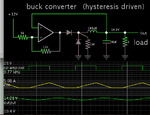matrixofdynamism
Advanced Member level 2
I was looking at schematic of the DE2-115 Altera FPGA development board. The purpose was to look at example of how te power delivery system has been designed in it.
I found that they are using "LM3150 Wide-VIN Synchronous Buck Controller" which is a switching regulator to generate
1) 1.2V/5A from a 12 V rail
2) 3.3V/6A from a 12V rail
Also, they are using some linear regulators to generate:
1) 5V/3A from same 12V rail (using LMZ12003)
2) 2.5V/1A from 3.3V rail of switching regulator (using LP38692MP)
3) 1.8V/1A from 3.3V rail of switching regulator (using LP38692MP)
Now I have these questions:
1) The schematic page for the switching regulators is attached. Why do we need so many external components to make it work?
2) Why did they not find a more "integrated" switching regulator that will require less external components?
3) Why not only use linear regulators for all rails or only switching regulators for all rails?

I found that they are using "LM3150 Wide-VIN Synchronous Buck Controller" which is a switching regulator to generate
1) 1.2V/5A from a 12 V rail
2) 3.3V/6A from a 12V rail
Also, they are using some linear regulators to generate:
1) 5V/3A from same 12V rail (using LMZ12003)
2) 2.5V/1A from 3.3V rail of switching regulator (using LP38692MP)
3) 1.8V/1A from 3.3V rail of switching regulator (using LP38692MP)
Now I have these questions:
1) The schematic page for the switching regulators is attached. Why do we need so many external components to make it work?
2) Why did they not find a more "integrated" switching regulator that will require less external components?
3) Why not only use linear regulators for all rails or only switching regulators for all rails?

